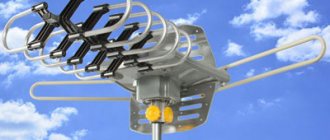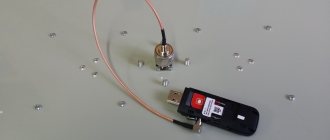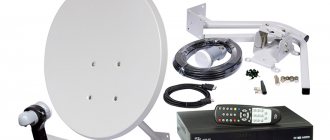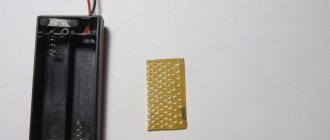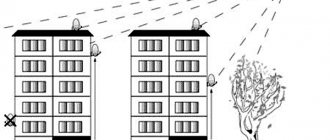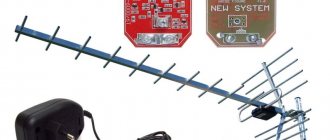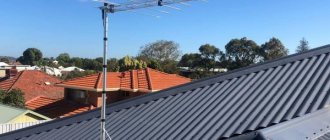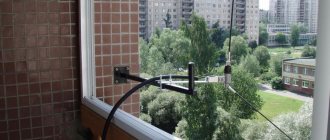Car GPS antenna
There are several reasons why you should install a GPS antenna in your car:
- improving the quality of navigation;
- more radio stations;
- the ability to receive both radio and television signals.
GPS antenna
Principle of operation
The main function of a car antenna is to receive signals from orbital constellations for navigation purposes. The complete work process is as follows:
- The satellite sends a message to ground stations. Since the position of the towers and the speed of the signal are known, the spacecraft can calculate its coordinates.
- The satellite sends a message with data about its own location to Earth.
- The antenna receives the signal and uses the spacecraft as reference points to determine its coordinates.
- The information received by the device is transmitted to the navigator. The device is also capable of receiving television and radio signals, transmitting them to the radio.
Types and fastening
There are several classification options. Antennas are classified according to the presence of an amplifier:
- Active. Supplemented with signal amplifiers. For this reason, the devices quickly detect large numbers of radio or television waves.
- Passive. Such devices are not equipped with amplifiers. The devices work well only if there is little interference in the area of action. If there are electrical appliances near the antenna, the reception accuracy will be low.
Another classification parameter is the mounting location. Both types of antennas are discussed in the table.
| View | Description | Flaws |
| External | Mounted outside the car: on the body, trunk, roof, bumper or fenders. Designed to search for television and radio signals. The remote device is highly sensitive. | Exposure to precipitation and temperature changes |
| Internal | Mounted inside the car (usually on the windshield). It is recognized as the most universal device, as it accepts all types of signals and is suitable for different devices. An amplifier is usually installed inside the case. | Costs much more than external |
There are also several ways to mount the device on a car:
- Overhead. Suitable for attaching the device to the rear bumper or drain. The device is supported on a special bracket mounted into the surface.
- Magnetic. The simplest, most universal way to mount the device on a metal surface. The only drawback is that the device becomes an easy prey for hooligans, so it is better to remove the device while parking.
- Interior. Convenient and reliable. The inner surface of the windshield, where the device will be attached, is treated with a degreasing compound. Then the device is labeled. The main disadvantage is the difficult dismantling when replacing glass.
- Mortise. Most often it is installed on the front fenders of the car. A hole is drilled in the surface through which the device is threaded, securing it from the inside. This method hides the main structure of the device.
GPS antenna
Adapters
The adapter is most often purchased by drivers who have replaced the radio in their car; for this reason, the antenna cannot be connected to the new device. An adapter is needed to connect two devices and “smooth out” the difference between them.
However, there are several more reasons to get an adapter:
- a small number of radio stations;
- low quality of playback of audio and video files;
- periodic disappearance of the signal;
- blurry picture or video distortion.
Mounting methods and designs
Based on the mounting method, external car antennas are divided as follows:
- With magnetic base. It is very convenient to place such a structure on the roof of a car. To prevent the base from scratching the paint, do not place it on a dirty body.
- Mortise. Installation requires, as the name suggests, cutting a hole in the body of the car. The installation site must be protected from corrosion.
- With clamps for fastening to the edge of the gutter. Not suitable for vehicles with plastic gutters.
Typically, an external antenna is an asymmetrical quarter-wave or half-wave vibrator (the latter, due to its large size, is somewhat less common). Structurally, it can be telescopic or pin in several versions: a steel pin, a steel spring in a dielectric casing, a flexible dielectric rod with a wire wound around it, covered with an insulating cover.
It is not possible to single out any design for the better. We can only note that the telescopic antenna wears out over time, due to which the contact between its links deteriorates, so when the car moves, a cracking noise will be heard in the receiver. According to the mounting method, a telescopic antenna is most often mortise-mounted. The remaining structures are fastened using any of the above methods equally often.
Specifics of receiving television programs
A car television antenna is always in difficult signal reception conditions. No matter what the seller tells you, and no matter how expensive it is, you can only get a stable picture without interference on the TV screen while driving for a short time, and then only by chance.
This is explained by the fact that the television signal, reflected from various obstacles, comes to the receiver in several ways. Reflections, when added to the main signal, can either strengthen or weaken it, so it is rarely at the optimal level and without interference.
And since it is much more complex than a signal from a news or music radio station, the requirements for good reception are higher. Therefore, the most you can hope for with a good antenna, if it is not satellite, is to watch TV in the parking lot.
Features of outdoor antennas
Placing a car antenna outside has at least one advantage over installing it inside the car - it is much less shielded by the body. Therefore, the reception quality of antenna devices located inside the cabin is almost never higher than that of devices located externally. Outdoor antennas, as a rule, are not equipped with an amplifier, that is, with rare exceptions, they are only passive. Contrary to popular belief, reception quality does not depend on the length of the antenna. The frequency range in which it operates depends on its length. The quality of reception largely depends on the height of its installation, so an antenna on the roof of a car, all other things being equal, will be a more preferable option, even if it is mortized.
Installing a GPS antenna in a car
At the very beginning of the process, a location for the GPS antenna in the car is determined. Next, the device is connected and configured, and possible problems are eliminated.
Installation
Before installing a GPS antenna in your car, it is better to choose a location for it. The most popular locations for installing the device include:
- wings;
- bumper;
- mirror;
- Windshield;
- roof;
- frame.
However, for each of them, different fastening methods are used: magnetic, mortise, internal or overhead.
GPS antenna on glass
Connection and setup
The device can be calibrated either in a specialized salon or independently, using the photo in the instructions. An approximate sequence of actions looks like this:
- The programs needed for operation are loaded onto the memory card. They are listed in the user manual.
- The memory card is inserted into the device and the main menu is turned on. From there you need to go to the “Options” item and enter the path to the programs.
- After completing the procedure, open the program and select the desired operating parameters.
The complete process of setting up the antenna is shown in the video at the end of the article.
Troubleshooting
After proper configuration, the device should not malfunction. However, it may produce some common errors:
- Interference with signal reception. An additional amplifier can solve the problem. If you urgently need to improve the signal, you can try to leave the area where other electrical appliances and cars are located.
- The device records incorrect data. In this case, you need to reflash the device.
- The internal antenna does not pick up the signal well. Then you should check the windshield. Tinted windows with metallic inclusions can block signals.
- The device stops working. It could be a simple disconnection from the power supply or a breakdown. It is best to check all the parts and wiring of the device.
Useful tips for car owners
On driver forums you can find the three most common recommendations regarding GPS antennas:
- Install in a specialized salon. Car owners complain that instead of wasting time and effort, they would prefer to pay 1,500 rubles for installation.
- Do not reflash yourself. If you install the wrong firmware version, the antenna will stop working altogether.
- Give preference to internal antennas with a wire connection. Drivers motivate this decision by the poor protection of external devices from precipitation and the instability of the Bluetooth channel.
Keep in mind
The type of antenna you choose depends on the nature of your travel. If the car is used within urban and suburban areas, it is better to choose a passive whip antenna of medium length, which works well in conditions of reliable reception. When traveling long distances or working in settlements remote from large cities, choose an active antenna. It has a built-in signal amplifier. Typically, such antennas are designed for interior design to prevent moisture from entering the antenna amplifier. However, when entering a city or crossing power lines, such an antenna may become “clogged” with external interference.
Choosing a GPS antenna for a car
When searching for a device, you need to rely on the technical specifications. The first of them is functionality. The device is capable of receiving three types of signals:
- Radio.
- Television.
- Satellite.
Devices can receive one type of signal or several. As a rule, combined type devices cost more. A cable connected to the on-board network or Bluetooth technology can be used as a communication channel. This indicator is reflected in the price of the device.
A combined technique for determining coordinates is also allowed - in addition to satellite systems, the device can determine its location using cellular communications. Car trackers work on the same principle. Devices with a GSM transmitter are capable of transmitting location data to a mobile phone or other device. Such devices cost more than classic models.
You can install a GPS antenna either in a specialized salon or on your own if you have instructions and simple tools. The main thing is to determine in advance the mounting location of the device.
So, for example, when choosing the Starline s96 bt gsm gps model, installation is carried out at a car dealership.
A little theory
Antennas for radio receivers differ in the range of received frequencies. This does not mean that the VHF antenna will not receive stations operating on medium waves at all, but the quality of the received frequency not in its own range will be much worse than the “native” one.
The ancestor of all antennas was the half-wave Hertz vibrator. All other antennas are essentially its modifications. Next, in Fig. 1 you can see the transformation of a half-wave vibrator into a quarter-wave vibrator.
In fact, most radio antennas for cars are like this. In them, the role of lower vibrators, called counterweights, is played by the metal of the car body. Therefore, good contact of the cable braid with the metal of the body is so important. And in the case of magnetic fastening of the device, the braid must be in reliable contact with the base body, which has capacitive contact with the body. In Fig. Figure 2 shows a so-called stocking antenna, in which a cable braid is used instead of the lower part of the vibrator.
Rice. 3 is a diagram of a quarter-wave vibrator.
Frequency ranges
Knowing the frequencies at which car radio equipment operates in our country will help you avoid making mistakes when choosing an antenna.
- The VHF “Soviet” radio range is from 65 to 74 MHz.
- FM radio frequency range “European” – from 87.5 to 108 MHz.
- FM radio frequency range “Japanese” – from 76 to 90 MHz.
- Meter television - from 48.5 to 230 MHz.
- UHF television - from 300 to 860 MHz.
VHF and FM stations provide better broadcast quality than MF and DV, but will only please you within line of sight, so don’t count on them far from populated areas.

